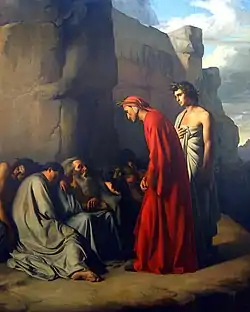Dante in Hell
Dante in Hell or Dante, led by Virgil, Consoles the Souls of the Envious is an 1835 oil on canvas painting by Hippolyte Flandrin. Contrary to its primary title, it shows a scene from the Circle of the Envious, the second circle of Purgatory in Canto III of Purgatorio. The scene depicts Dante on the mountain of Purgatorio trying to comfort the blind men. It is now in the Museum of Fine Arts of Lyon.

Dante's Inferno Dante’s Inferno in an epic poem written by the italian poet and philosopher. The poem follows Dante through inferno (hell), purgatorio (purgatory), and paradiso (heaven), guided by the poet Virgil. There are nine circles that exist within these realms, some containing multiple sub circles. Virgil guides Dante through hell and heaven to his beloved Beatrice, who originally sent Virgil. Throughout the novel, Dante struggles with faith. There are many symbols and motifs that reinforce Dante’s uncertainty of God. Dante’s fear of the underworld and it’s creatures stifles his pursuit of religion. There are many ways to interpret this, some see this as an allegorical vessel through which Dante Alighieri conveys the trials and tribulations of humanity’s faith or the ascent to the Cristian God’s path. JSTOR, Purgatorio III https://www.jstor.org/stable/44806825
Hippolyte(-Jean) Flandrin Hippolyte Flandrin was a french painter and lithographer. After his brother Auguste’s art career proved unsuccessful, Hippolyte was dissuaded from pursuing his dream of becoming an artist. In 1821, a family friend and artist, Denys Foyatier, convinced Hippolyte and his brother Paul to study the arts. The two brothers started studying with the sculptor Jean-François Legendre-Héral and painter André Magnin. Hippolyte worked freelance selling lithographs to support his family. In 1826, both Hippolyte and Paul enrolled at Ecole des Beaux-Arts in their hometown of Lyon, France. Hippolyte showed innate talent which led him to Paris. He and his brother began studying at the studio of Ingres. Under Jean-Auguste-Dominique Ingres mentorship, Hippolyte won the Grand Prix de Rome. A year later he and his brother moved to Rome where Hippolyte painted more religious paintings such as ‘Dante in Hell’.
Sources
LANSING, RICHARD H. “Purgatorio III.” Lectura Dantis, no. 12, 1993, pp. 35–52. JSTOR, www.jstor.org/stable/44806522. Accessed 11 Dec. 2020.This source analyzes the third canto of Purgatorio. Plenty of context and lengthy to expand on the wikipedia article and gain an understanding of the characters involved.
"Flandrin family." Grove Art Online. 2003. Oxford University Press. Date of access 10 Dec. 2020, This article focuses on the Flandrin family. Contains a long portion about Jean-Hippolyte Flandrin and his artistic career. Highlights his achievements and artistic focuses.
Driskel, Michael Paul. “Painting, Piety, and Politics in 1848: Hippolyte Flandrin's Emblem of Equality at Nîmes.” The Art Bulletin, vol. 66, no. 2, 1984, pp. 270–285. JSTOR, www.jstor.org/stable/3050417. Accessed 12 Dec. 2020. This article is an in-depth look at Hippolyte Flandrin's career and specifically his downfall as an artist despite being one of Ingres’s most accomplished students.
- Léon LAGRANGE, Hippolyte Flandrin, sa vie et ses œuvres, in Le Correspondant, 11 Avril 1864, p745